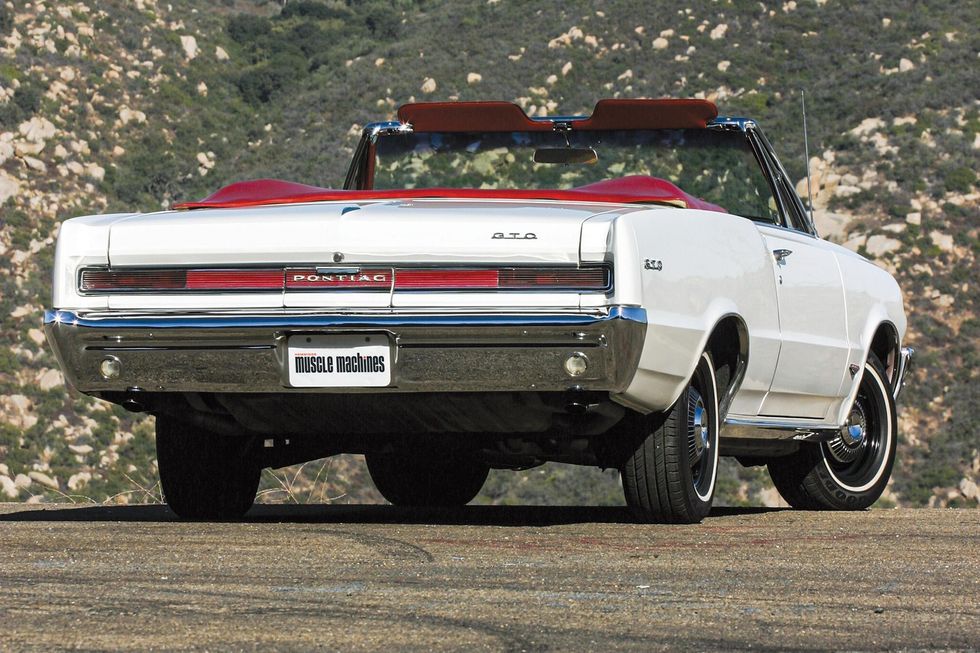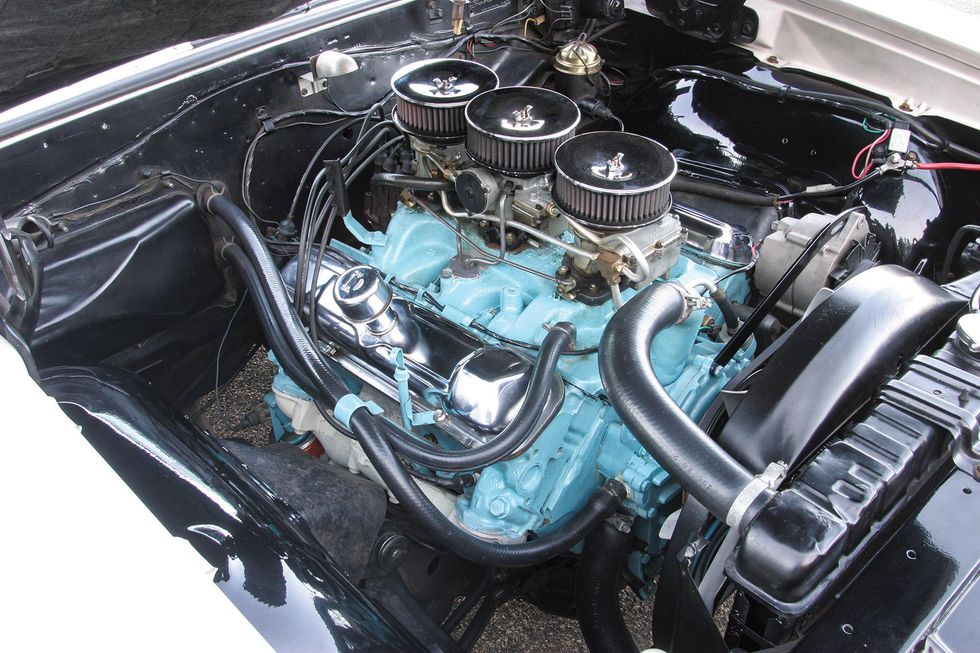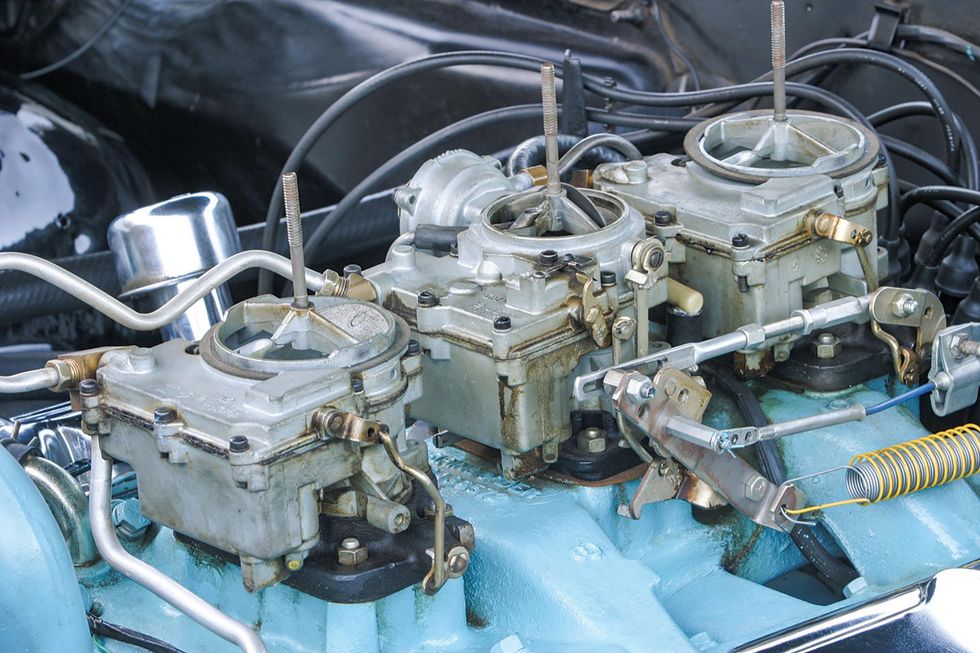Buyer's Guide to the 1964 Pontiac GTO
The Pontiac Synonymous with ’60s Performance is Still a Perennial Favorite
03/12/2023

Photography from the Hemmings Archives
Buyer's GuidesThe Pontiac Synonymous with ’60s Performance is Still a Perennial Favorite

For some Baby Boomers, Pontiac’s GTO is the automotive equivalent of Jimi Hendrix’s Star Spangled Banner guitar shred at Woodstock: powerful, iconic and emblematic of an extraordinary era in American history. Pontiac offered a GTO until 1974, then dusted off the badge again for its last hoorah 30 years later on the 2004- ’06 edition. A few versions of the model were significant, at least one was legendary (we’re looking at you, The Judge), but it was the pure-and-simple ’64 that lit the fire. The GTO’s origin story is almost as legendary as the car’s performance reputation. In the late 1950s, Pontiac General Manager Semon E. “Bunkie” Knudsen resuscitated the brand with an infusion of electrifying styling and performance. The division also firmly established itself in motorsports and became America’s third best-selling automaker. All of this attention neatly coincided with many Baby Boomers reaching driving age. When Knudsen left for Chevrolet in the early 1960s, Pontiac was flush with talent, and the young engineers he’d hired to aid in the division’s turnaround were promoted. E.M. “Pete” Estes became Pontiac’s general manager and John DeLorean became its chief engineer.

Photo from the Hemmings Archives
These young execs recognized the need for a fast, agile, affordable car that could further expand Pontiac’s performance image. The perfect candidate arrived in ’64: the mid-size A-body that replaced the compact Y-body. The new car eschewed the earlier model’s advanced unit-body platform, swing-axle rear suspension and transaxle, in favor of more traditional architecture: a full-frame, a solid axle with four-link rear suspension and a conventional drivetrain layout. As a result, the 389 V-8 engine from the full-size line, and three- or four-speed manual transmissions could easily fit in the A-body. Paired with heavy-duty suspension, the car’s handling qualities could be elevated to equal the big engine’s performance.
As the story goes, during tests of a ’64 Tempest at the Milford Proving Grounds, Pontiac chassis engineer Bill Collins noted that the 389 would fit in the new chassis, engineer and engine specialist Russ Gee proposed the swap and DeLorean agreed. Soon after, a running prototype was completed.
The name “GTO” was chosen for this performance edition; it’s an acronym for “Gran Turismo Omologato.” When used on a Ferrari, it meant it was homologated by the Fédération Internationale D’Automobile for racing. Pontiac’s GTO wasn’t, but the name implied exotic performance, and that was good enough.
At the time, GM had limited its intermediate cars to a 330-cu.in. V-8 ceiling, so to get around that, the GTO was offered as an option instead of a model. Thus, for $295.90, code 382 turned a Le Mans into a GTO with all of the performance bona fides, plus emblems, blacked-out grilles, and hood scoops to make it stand out. Just $2,776 ($27,000 in 2022) bought you the base pillared GTO sports coupe.
Many road testers were enthusiastic about the GTO’s style and acceleration. Others panned it for its name and other short-comings, like its brakes. Nevertheless, the overall impression was positive. A masterful marketing campaign for the GTO by Jim Wangers and his team at Pontiac’s ad agency MacManus, John & Adams, did more than a little to create that same impression among buyers. With 32,450 GTOs sold that first year, the formula for success was established.
First generation GTOs have been a mainstay of the collector car hobby for decades due to their popularity among Boomers. According to multiple value guides, 1964-’67 GTO prices have remained fairly steady over the last five years averaging in the $50,000- $60,000 range, overall. The ’64—which we’re singling out for analysis here—has followed a similar trend. One of the more notable, recent sales of a ’64 GTO occurred back in July 2022, at a GAA Classic Cars auction in Greensboro, North Carolina. The car was a nicely restored black coupe and it changed hands for $88,000. At Mecum’s Chicago auction in October, a good-looking black ’64 convertible sold for $64,000; at the company’s Kissimmee sale in January, a stunning black convertible sold for an impressive $107,250. Meanwhile, on the more affordable end of the market, a very presentable, driver-quality ’64 coupe was sold by its second owner on Hemmings Auctions in September for $24,460.
The GTO’s traditional fanbase is still a driving force in the collector car hobby, but it’s gradually turning the market over to Generation X and Millennials, who may be less interested in cars of the early 1960s. Still, the original GTO isn’t going anywhere anytime soon. It’s probably safe to say that expertly restored examples and cars with professional-grade restomod treatments will continue to command lofty prices, but the overall value trend will remain steady into the foreseeable future. If you’re in the market for one of these pioneering American performance machines, here are some points to keep in mind.
Photo from the Hemmings Archives
The GTO’s standard-issue 389 was topped with a Carter four-barrel carburetor and rated at 325 hp at 4,800 rpm/428 lb-ft of torque at 3,200 rpm. The Tri-Power option swapped the four barrel for three Rochester two-barrel carburetors. The center carburetor acted as the primary and, when the throttle was two-thirds open, the outer carbs kicked in via a vacuum-diaphragm-controlled linkage.
Pontiac advertised the Tri-Power 389’s output as 358 hp at 4,900 rpm/428 lb-ft at 3,600 rpm. Both engines came standard with a cast-iron, dual-plane intake manifold; 421 H.O.-spec cylinder heads with larger ports; 1.92-inch intake/1.66-inch exhaust valves and HD valve springs; cast-aluminum pistons helping to deliver 10.75:1 compression; a cast crank and rods spinning in a block with five main bearings and two-bolt main caps; and iron exhaust manifolds feeding dual exhaust. The single four barrel and Tri-Power 389s used a hydraulic flat-tappet cam with 273/289-degrees advertised duration and .410/413 lift activating 1.50:1 ratio rocker arms. To help keep the package cool, a seven-blade 18-inch declutching fan was also included. The 389 is a generally reliable engine but be sure to check for any odd noises, smoke, and leaks that would indicate mechanical issues due to age or neglect. Many owners added Tri-Power to their ’64 GTOs years after purchase, so be diligent in checking engine codes and date codes to ensure that a purported factory Tri-Power GTO is accurately represented.
There are no new stock-replacement engine blocks or iron heads being reproduced, and though cores are getting scarce, they are still available. If you’d like to modify your GTO, large-bore aftermarket Pontiac-style blocks, various aluminum cylinder heads and intake manifolds, and carburetor and EFI options are offered. There are also solid and hydraulic flat-tappet and solid and hydraulic roller camshafts, forged rods and pistons, cast and forged cranks, and stroker kits on the market.


A three-speed manual was standard in the GTO; the Muncie M20 wide-ratio and M21 close-ratio four-speeds were optional. (The latter required 3.90 or 4.33 rear axle gears.) All were paired with a 10.4-inch-diameter clutch in an aluminum bellhousing. A two-speed, Super Turbine 300 automatic, modified internally to handle the GTO’s torque, was an extra-cost option.
All of these transmissions are generally durable. Check for excessive gear noise and shifting issues with manual gearboxes, which would indicate worn parts. Automatics should be examined for proper shifting without slippage and the fluid checked for proper color (red not brown), and to ensure it doesn’t smell burnt. Overdrive transmission swaps are possible—manual and automatic—for more relaxed highway driving.

Photo from the Hemmings Archives
The new-for-’64 A-body rode on a perimeter frame with torque boxes and convertibles employed a boxed-side-rail frame for additional stiffness. The chassis featured an SLA-type independent front suspension with a .938-inch anti-sway bar while the rear featured a four-link suspension. Heavy-duty coil springs and shocks were used at the four corners.
A ride-and-handling package with firmer shocks and with or without a quicker 20:1 steering ratio was optional. Standard steering featured a 24:1 ratio and five turns to lock. Optional power steering reduced the steering effort and the ratio to 17.5:1 and 4.2 turns-to-lock.
Manual 9.5-inch four-wheel drum brakes were standard and power assist was optional. The 8.2-inch, 10-bolt rear-end offered gear ratios from 3.08:1 to 3.90:1, while 4.33:1 gears could be dealer installed. Some restrictions existed due to engine and option choices. Safe-T-Track (limited-slip) was optional.
Wider 14 x 6-inch steel wheels shod with 7.50 x 14 nylon cord bias-ply redline tires were standard on the GTO, as were hubcaps. Full wheel covers were optional.
Check closely for rust or rust repairs around the torque boxes and along the side frame rails. Also look for evidence of accident damage that may have required the frame to be pulled back into alignment.
The suspension, steering, and brake systems were shared with Chevrolet, Buick, and Oldsmobile A-bodies, so replacement parts are readily available if your examination turns up worn items.

Photo from the Hemmings Archives
GTOs were offered in sports coupe (post), hardtop, and convertible body styles. The ’64’s nose was reminiscent of the ’63 Le Mans with its split grilles and quad horizontal headlamps, but the look was updated for the new car. The overall body shape was more modern and boxier. The ’64 was also 8.7 inches longer than its predecessor at 203 inches, yet .9 inch narrower at 73.3 inches.
Rust is very common in the rear quarter panels, the wheel wells, the rocker panels, the lower doors (inner and outer), the lower front fenders, the cabin floors, the trunk floors, and around the windshield and rear window. Many of these cars have been restored over the years so look for signs of previous metal work. There are a variety of repair panels and full panels offered for these cars, but reproduction body-part availability lags slightly behind the ’66-’67 GTOs.
Also, when shopping, it’s a good idea to check that the GTO you’re considering actually is a GTO. The VIN plate is attached to the driver-side door pillar. An example is 824P1001: “8”=eight-cylinder engine; “2”=Le Mans (“0”=Tempest, “1”=Tempest Custom); “4”=1964; “P”=Pontiac MI assembly plant; “1001” sequential serial number. As you can see, since the GTO was an option on the Le Mans, there’s no designation that’s specific to it, only the Le Mans, Tempest, and Tempest Custom. (A quick method for determining if a Pontiac- or Kansas City-built car is a real GTO is to look for “5N” on the accessory line of the cowl data plate.)
To be sure, a package can be purchased from PHS Automotive Services (phs-online. com) that’s specific to your car and will contain copies of a dealer order form that has the original options for that particular car highlighted; factory billing history; code breakdowns for the VIN, cowl data plate, engine, transmission and rear end; press releases for the GTO’s introduction; and a press photo of a GTO.
The GTO’s standard-issue cockpit was furnished with front bucket seats upholstered in the buyer’s choice of black, red, saddle, aqua, dark blue, or parchment “Morrokide” vinyl. A Hurst floor shift for the three-speed was also part of the package and an engine-turned instrument panel applique surrounded the instrument cluster. Optional equipment was plentiful, in typical Pontiac fashion, and included a faux-wood custom sports wheel, seven-position tilt column, a tachometer, vacuum gauge, padded dash, center console, air conditioning, power windows, power tilt driver’s seat, and more. GTOs with automatic transmissions and no console came with a column shift, but that was moved to a more sporting position between the seats when the center console box was checked on the option sheet.
Reproduction interior parts are plentiful; for less than $3,500 as of this writing, you can buy virtually everything needed to give a ’64 GTO cockpit a complete makeover with fresh carpet, upholstery, and trim pieces.
WHAT TO PAY
What To Pay | Low | Average | High |
Sports Coupe | $30,000 | $54,000 | $74,000 |
Hardtop | $35,000 | $62,000 | $81,000 |
Convertible | $80, 000 | $145,000 | $200,000 |
PARTS PRICES
Parts | Price |
Full quarter panel | $665 |
Gas tank | $164 |
GTO dash emblem | $44 |
Hood | $870 |
Tachometer, in dash | $193 |
Trunk floor | $773 |
Power disc brake conversion kit | $782 |
Wiring update kit | $720 |
Interior kit complete | $3,466 |
The 1964 Pontiac GTO is a classic American muscle car, renowned for its role in shaping the muscle car movement. It's a high-performance version of the Pontiac Tempest and is often considered the first true muscle car.
The 1964 GTO earned this title because it combined a powerful 389 cubic-inch V8 engine with a mid-size car platform. This concept of putting a big engine in a smaller car became the blueprint for muscle cars to come.
The 1964 GTO was equipped with a 389-cubic-inch V8 engine, which was available in multiple configurations. The base version produced 325 horsepower, while the Tri-Power option pushed it to 348 horsepower.
Key features of the 1964 GTO include its powerful V8 engine, dual exhaust, sporty exterior styling, distinctive twin hood scoops, bucket seats, and a floor-mounted shifter.
The 1964 GTO was known for its quick acceleration. It could go from 0 to 60 mph in approximately 7 seconds, which was quite impressive for its time.
The 1964 GTO stood out for its incredible value, offering a potent V8 engine, aggressive styling, and spirited performance at an affordable price. This combination of attributes made it extremely popular.
In its inaugural year, Pontiac produced a total of 32,450 GTOs. The significant production numbers reflect its immediate popularity.
Common issues may include rust, which can develop over time due to the car's age. Owners should also be vigilant about maintaining the engine and transmission, as with any classic car.
Market values for well-preserved 1964 GTOs vary significantly based on factors like condition, originality, and demand. Typically, they can range from $30,000 to $70,000 or even higher for exceptional examples.
Yes, the 1964 GTO is highly regarded as a classic and collector's car. It's celebrated for its pioneering role in the muscle car era, and its enduring appeal makes it a sought-after collectible.
Spring is here. As the snow melts and the daffodils bloom, it’s time for many vintage cars to emerge from winter hibernation and get back on the road. Thinking of adding to the collection? We have 10 vehicles in spring-like shades of yellow – including cars and trucks, U.S. and European – to catch your eye.


















































Tim Kuniskis, longtime Stellantis executive and a prominent voice in the modern-day American muscle car era, is retiring after 32 years with the company. Kuniskis, also known as the godfather of the Hellcat V8, was appointed Brand Chief Executive Officer (CEO) of Dodge and a member of Stellantis' Top Executive Team in January 2021. He took charge of Ram in July of 2023. His retirement begins on June 1st of this year.
With Kuniskis leading the way, the Dodge brand embraced its American muscle car image, further building a passionate fan base for its high-performance vehicles, including the Charger, Challenger, and the Viper, by introducing the “Brotherhood of Muscle.” We saw the return of Dodge’s Direct Connection subbrand, which makes tuning products more accessible to its enthusiasts.
Kuniskis was there through Dodge’s Last Call campaign, the brand’s final send off for two of its iconic V8-powered muscle cars, the Dodge Challenger and Charger models, before turning the page to the next generation. Dodge’s Last Call models included the 2023 Dodge Challenger R/T Scat Pack Shakedown, 2023 Dodge Charger Super Bee, 2023 Dodge Challenger R/T Scat Pack Swinger, 2023 Dodge Charger R/T Scat Pack Swinger, 2023 Dodge Charger King Daytona, 2023 Dodge Challenger Black Ghost, and the 2023 Dodge Challenger Demon 170. He also oversaw the next generation muscle car’s reveal, which confirmed the offering of an all-electric powertrain, plus he played a key role in the reveal of the all-electric 2025 Ram.
“I want to take the opportunity to warmly thank Tim for his passion, commitment and contributions to Stellantis and in defining the vision of the future electrified Ram and Dodge brands,” said Stellantis CEO, Carlos Tavares. “I wish him well in his retirement.”
Tim Kuniskis’s retirement comes at a challenging time for the company. Dodge has seen a drop in sales since the phase out of the previous Challenger and Charger models. Sales were down by 16-percent for the Charger coupe and sedan in Q1, while at the same time, Ram sales reportedly dropped by 26-percent. Vehicle shipments worldwide were down 10-percent (to 1.3 million) compared to the same three-month period a year ago. Stellantis revenue declined by a total of 15% to $20.7 billion.
Stepping up to the company’s future challenges in Kuniskis’s place is Matt McAlear, the new CEO of Dodge, who led Dodge's sales operations in the recent past. Christine Feuell, prior Chrysler CEO who had a hand in the reveal of the Halcyon Concept earlier this year, will now be in charge of the Ram brand.

Christine Feuell
Stellantis

Matt McAlear
Stellantis
“I am confident that Chris will continue the work of Tim in leading the iconic Ram brand,” said Tavares. “Matt will bring a fresh perspective, while continuing to draw on the heritage of our iconic Dodge brand and leading the transition of the brand toward a sustainable future.”